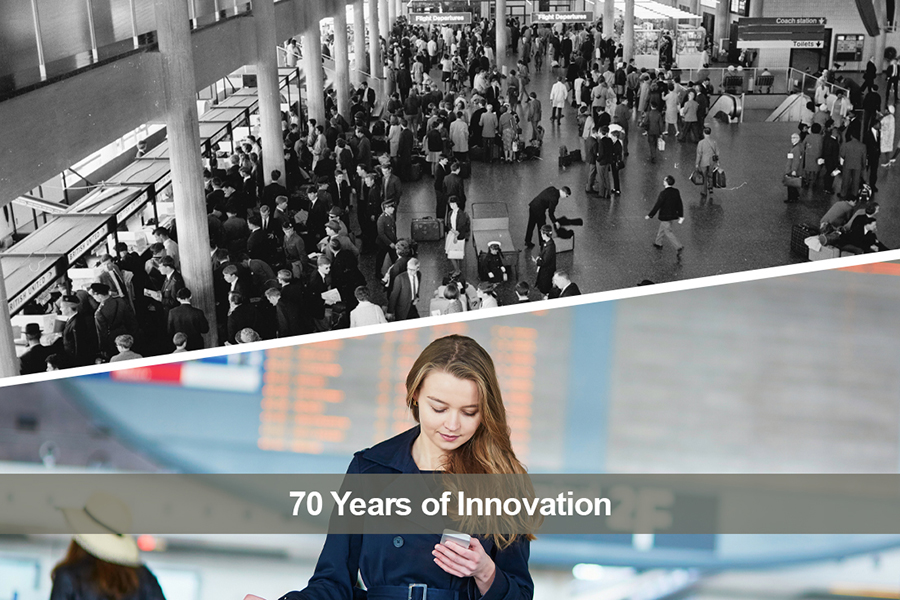Open Day showcases innovations across SITA
SITA created its Open Day* as an opportunity for employees to step back from the usual day job and instead come together and focus on some central themes of the air transport industry. Twenty-four hours of collective thinking to share, collaborate and have fun together.
Initiatives like this are one of the main reasons I love working for SITA, and I was especially happy to see ‘Let’s talk technology trends’ high on the agenda. I know that technology is central to our business, but it was great to hear some of my colleagues’ thoughts on innovation and the ways we experience emerging technologies in everyday life.
Innovation: what are the leaders doing?
We were asked to consider who we thought the most innovative companies today are, and what traits they have in common. There was general agreement that organizations that put the customer first, with the necessary drive and ambition to enhance the customer experience, would score highly. After some lively discussion, the 10 most innovative companies of 2019 were revealed:
- Amazon
- Apple
- Microsoft
- Samsung
- Netflix
- IBM
- Tesla
- Adidas
Many of the names on there came as no surprise, though it was interesting to hear that some of them are less than 15 years old. Whether they are free to operate with a startup mindset or not, one thing was unanimous: all these technology leaders promote a culture that enables themselves and others to collaborate and aggressively innovate on new products, services, and ways of working.
And what about SITA?
SITA is no stranger to innovation. The company has been pioneering and innovating across the air transport industry since its inception. We discovered how SITA continues to explore potential ideas, constantly co-innovating with its members, and customers.
It was fascinating to see how far SITA has come, with examples such as activating the world’s first nodal distributed network, seen as an early internet, back in 1969. Putting the focus on improving the passenger journey at the forefront of our minds, we brainstormed some of the other technologies that have revolutionized air travel.
Ones that stood out for me include, in 1984, we launched the first IT for check-in, and in 1995 made e-commerce history with the first real-time travel and bookings payment website. The pinnacle of a sporting career for an athlete is the Olympic Games, and it was great to hear that we played a part—developing the world’s first e-visa system for the Sydney Olympics in 2000.
It was a fun exercise to look back through some of the company milestones and realize that we take many of these technologies for granted these days. So, what of the future? If the world’s most innovative companies today are pushing the boundaries of what will be possible tomorrow, what technologies will be expected as the norm by passengers in the future?
The technologies of tomorrow: Blockchain, AI, ML and Computer Vision
The Open Day session did a great job of emphasizing some of the incredible work our past colleagues helped pioneer, and the discussion moved to what roles current SITA employees are playing in the development of emerging technologies. We focused on a few select ones: blockchain, artificial intelligence (AI), machine learning (ML), and computer vision.
In simple terms, blockchain is a ledger of digital events that can be replicated, shared, and trusted without the necessity of central authority. Digital information is distributed, but not copied, via time-stamped series of unalterable records of data that are managed by clusters of computers and not owned by any single entity. Fintech and digital currencies are a great example of innovation in this space.
I was excited to hear what commitment SITA has made to blockchain technology, understanding that the ability to share and record common data without giving up control of that data is fundamental to driving new efficiencies in air travel.
Collaboration is central to SITA’s blockchain innovation. One project that I thought highlighted this perfectly is the MRO Blockchain Alliance, air transport’s first industry-wide investigation into the use of blockchain to track, trace, and record aircraft parts.
An ongoing exploration of blockchain promises tremendous opportunity for streamlining the sharing and recording of information across the air transport industry, and it seems that more exciting times are to come.
AI is real, and it is revolutionary
Everyone in the room agreed, AI seems to be one of the biggest buzzwords around! The reason for that is simple—AI is real, and it is revolutionary. AI and ML allow us to learn from historical data to make predictions or decisions, without being specifically programmed to perform the task.
It is already disrupting many industries and can be witnessed in action daily when Amazon and Netflix spoon-feed us personalized suggestions on what to buy or watch next based on our historical actions.
Companies like Amazon and Netflix use AI to enhance the shopping and viewing experience, SITA is investing in AI to enhance the passenger experience. Some of my colleagues I interacted with at Open Day are working tirelessly on such technologies and offered a great example of it in action at Singapore Changi Airport.
Here, they are using the power of AI and ML to predict future flight movements and optimize gate allocation more accurately. By drawing valuable insights from historical data on flight delays and coupling it with real-time information, they can successfully plan for arrivals to provide an improved passenger flow.
Innovating with imagery through Computer Vision
We’ve all been there: that first visit to a new country with an alien-looking set of characters that forms their alphabet. Google understands that pain too. The company has gradually increased the functionality of its translation application to reach a level of sophistication where you can capture a set of text with the camera and see the translation at a click of a button.
This camera capability—for computers to “see” and understand the world based on the content of digital images—is fascinating. The potential of computer vision is enormous. When SITA employees were developing the technology of the ‘60s, the thought of self-driving cars would have been a pipe dream. Computer vision is bringing these ideas to reality.
Computer Vision looks set to play a large role in delivering a seamless passenger experience across the air transport industry. Used in turnaround management, airlines will have better visibility over the process, identifying any issues before they arise, which, of course, leads to better on-time performance.
The future is coming fast
My takeaways from the Open Day are clear: we can look forward to a future that will be intelligent, digital, connected, and shared.
Every one of SITA’s past innovations, to the ones we can look forward to in the future, would not have been possible without the expertise within the company. Demonstrating these 70 years of innovation across all areas of the business to employees throughout the world on the same day makes for quite the challenge. But it’s initiatives like Open Day that perfectly display SITA’s path to success and inspire the next generation of innovators to create great things.
*SITA’s Open Day is an annual event based on a coordinated time for employees in over 30 of SITA’s main locations around the world to join in activities, share experience and enjoy team-building games and learning modules, covering SITA history, strategy, innovations and more.





 Share
Share



0 Comments